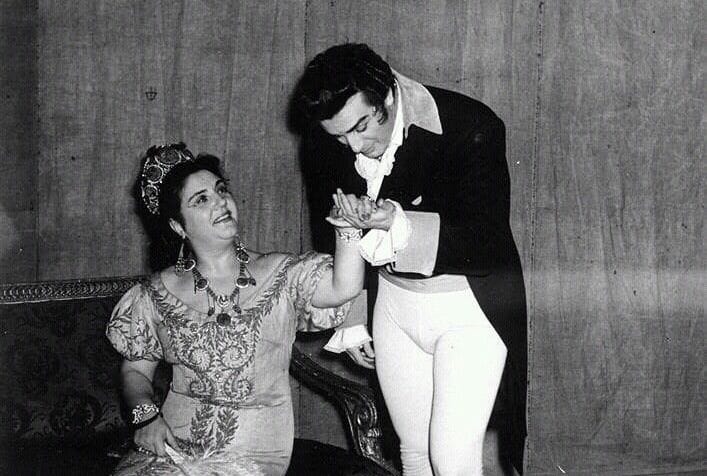Maria Caniglia: A Life in Opera’s Limelight

Maria Caniglia was born in Naples on 5th May 1905. It was considered a blessing when Agostino Roche accepted her as his student, since he was responsible for the stellar technique of Ebe Stignani, one of the great mezzo sopranos of the 20th century. Stignani was older than Caniglia by two years and made her debut five years ahead of her. From the very first time Caniglia heard Stignani, she was astounded, not having the faintest idea that in time to come both were destined to sing together constantly. Roche claimed from the beginning that Caniglia was a spinto since her voice was large and filled with energy and enthusiasm.
In 1929, Roche sent Caniglia to La Scala to audition for three major conductors: Gino Marinuzzi, Ettore Panizza and Giuseppe Del Campo. All three were unanimous in their verdict and Caniglia was called for a second audition after a couple of months for a group of lyrical arias. Auditions can be tricky as the singer is nervous, the house empty and there is no orchestra.
Caniglia studied at the Conservatory San Pietro a Majella in Naples and made her debut in Turin in 1930 as Chrysothemis in Elektra. That same year she made her first appearance at La Scala as Maria in Ildebrando Pizzetti’s Lo straniero. She sang there regularly until 1943 and again from 1948 to 1951. She sang at Covent Garden in 1937, 1939 and with the Scala company in 1950; and at the Met during the 1938-39 season. Among the roles she created were Manuela in Italo Montemezzi’s La Notte di Zoraima (1931, Milan), Roxane in Franco Alfano’s Cyrano de Bergerac (1936, Rome) and the title role in Ottorino Respighi’s Lucrezia (1937, Milan).
Caniglia sang most of Verdi’s lyric-dramatic soprano roles from Leonora in his first opera Oberto at La Scala to Alice in Falstaff. Caniglia left La Scala in 1951. She felt that all the choice roles were going to Renata Tebaldi and Maria Callas. She moved permanently to the Rome Opera where she had been a frequent guest, and became a big attraction. In all, she appeared in 33 different operas in Rome and in 36 at La Scala.
Conductors were kind to the singer. Italian conductor Tullio Serafin advised Caniglia never to undertake either Madama Butterfly or Ernani. “You are too emotional for Butterfly,” he told her. “This opera would destroy you in no time, for you will always be unable to control your feelings. You have a top, but it is not your glory, for Elvira in Ernani the upper range must be exceptional or it does not come off. You could manage it, but with the hundreds of roles at your disposal, why not concentrate on what you can do best?”
From lyric roles, Caniglia went into the spinto repertoire. In the last years of her career, she was forced to take on dramatic roles to help the opera houses. Maria Carena had retired, Iva Pacetti and Gina Cigna retired due to ill health. There seemed to be a shortage of dramatic sopranos. Because of this, Caniglia touched the bel canto operas first—Norma,La vestale and Poliuto. Later she added Nabucco, La Gioconda and La fanciulla del West.
La Scala used to hold immense prestige. Once it announced you for a new role in the forthcoming season, there would be a number of requests to repeat it in other theatres. Because of Caniglia’s warm timbre, she accepted many verismo operas like La Wally, Cavalleria rusticana, Guglielmo Ratcliff, Francesca da Rimini, Andrea Chénier and Fedora.
Too many verismo roles, thrilling as they are for the singer, can also be dangerous, for they lie in the middle of the voice. Caniglia always believed in going to the source for advice. When preparing for Manon Lescaut, she went to Carmen Melis and for La fanciulla del West to Gilda dalla Rizza as they were great interpreters of these Puccini operas.
Caniglia had sung many Verdi roles, but the one that most affected her was Leonora in La forza del destino, “where the duet ‘La Vergine degli angeli’ comes with the bass and chorus. The setting with all the monks carrying candles is so awe-inspiring I was never able to sing it without weeping. Since my husband passed away, I have thought increasingly about death and how wonderful it would be to go into the beyond to the tune of that music, praising the Holy Virgin.”
Caniglia was much admired as Tosca, Adriana Lecouvreur, Fedora and Leonora. No one deserved to enter the gates of heaven the way she wished more than she did, for she brought a warm human quality and dramatic excitement to her performances. The Stuart-Liff Collection includes an LP featuring Caniglia in one of her great roles, that of Amelia in the opera Ballo, with Beniamino Gigli.
By Jimmy Bilimoria. This piece was originally published by the National Centre for the Performing Arts, Mumbai, in the February 2024 issue of ON Stage – their monthly arts magazine.





